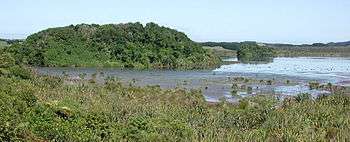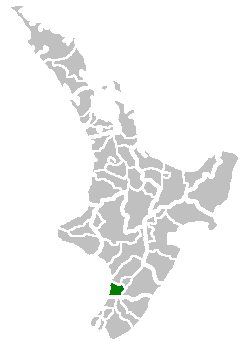Horowhenua District
Horowhenua District is a local government district on the west coast of the North Island of New Zealand. It forms part of the Manawatū-Whanganui region. Its name roughly means shaking or rippling earth.
Horowhenua District | |
|---|---|
 Lake Papaitonga | |
 | |
| Country | New Zealand |
| Region | Manawatū-Whanganui |
| District | Horowhenua District Council |
| Wards | Levin Waiopehu Miranui Kere Kere |
| Seat | Levin |
| Government | |
| • Mayor | Bernie Wanden |
| • Deputy Mayor | Jo Mason |
| Area | |
| • Total | 1,063.60 km2 (410.66 sq mi) |
| Population (June 2019)[1] | |
| • Total | 35,000 |
| • Density | 33/km2 (85/sq mi) |
| Time zone | UTC+12 (NZST) |
| • Summer (DST) | UTC+13 (NZDT) |
| Postcode(s) | |
| Website | Horowhenua District Council |
Located north of Wellington and Kapiti, the district stretches from slightly north of the town of Ōtaki in the south to just south of Himatangi in the north, and from the coast to the summit of the Tararua Ranges.
The main town and seat of the district council is Levin, and other towns in the district include Foxton, Shannon, and Tokomaru. The population of the district is 35,000 (June 2019).[1]
Populated places
Horowhenua District consists of the following towns, localities, settlements and communities (larger towns shown in bold):
|
|
Demographics
| Year | Pop. | ±% p.a. |
|---|---|---|
| 2006 | 29,868 | — |
| 2013 | 30,096 | +0.11% |
| 2018 | 33,261 | +2.02% |
| Source: [2] | ||
Horowhenua District had a population of 33,261 at the 2018 New Zealand census, an increase of 3,165 people (10.5%) since the 2013 census, and an increase of 3,393 people (11.4%) since the 2006 census. There were 13,230 households. There were 16,143 males and 17,118 females, giving a sex ratio of 0.94 males per female. Of the total population, 6,087 people (18.3%) were aged up to 15 years, 5,244 (15.8%) were 15 to 29, 13,707 (41.2%) were 30 to 64, and 8,223 (24.7%) were 65 or older. Figures may not add up to the total due to rounding.
Ethnicities were 81.0% European/Pākehā, 24.5% Māori, 5.7% Pacific peoples, 4.1% Asian, and 1.6% other ethnicities. People may identify with more than one ethnicity.
The percentage of people born overseas was 14.1, compared with 27.1% nationally.
Although some people objected to giving their religion, 51.1% had no religion, 36.0% were Christian, and 3.8% had other religions.
Of those at least 15 years old, 2,877 (10.6%) people had a bachelor or higher degree, and 7,806 (28.7%) people had no formal qualifications. The median income was $23,900. The employment status of those at least 15 was that 10,905 (40.1%) people were employed full-time, 3,567 (13.1%) were part-time, and 1,311 (4.8%) were unemployed.[2]
Land use in Horowhenua
Much of the area was once an extensive wetland and the centre of a substantial flax industry. It has been progressively drained and converted to productive but flood-prone farmland, with a mixture of loam and peat based soils. Some parts of the wetland, particularly those around Lake Horowhenua are being returned to their former state as a conservation area, with the help of local Māori. One of the local tribal authorities is the Muaūpoko Tribal Authority.
Museums
- Te Awahou Nieuwe Stroom - Foxton
- Piriharakeke Generation Inspiration Centre - Foxton
- Oranjehof Dutch Connection Centre - Foxton
- Flax Stripper Museum - Foxton
- MAVTech - Museum of Audiovisual Technology - Foxton
Schools in Horowhenua District
Secondary
- Manawatū College, Foxton
- Horowhenua College, Levin
- Waiopehu College, Levin
Primary
- Foxton Beach School, Foxton Beach
- Coley Street School, Foxton
- Foxton Primary, Foxton
- St. Marys, Foxton
- Levin East School, Levin
- Fairfield School, Levin
- Ohau School, Ohau (Levin Rural)
- Koputuroa School, Levin Rural
- St. Josephs, Levin
- Levin School, Levin
- Levin North School, Levin
- Taitoko School, Levin
- Poroutawhao School, Levin Rural
- Shannon School, Shannon
- Manakau School, Manakau
- Opiki School, Opiki
- Tokomaru School, Tokomaru
Intermediate
- Levin Intermediate, Levin (Years 7 & 8 only)
Sport
In rugby, a combined Horowhenua-Kapiti team represents the area in the amateur Heartland Championship.
In cricket, a Horowhenua-Kapiti team has competed in the Hawke Cup since 2002.
References
- "Subnational Population Estimates: At 30 June 2019". Statistics New Zealand. 22 October 2019. Retrieved 11 January 2020.
- "Statistical area 1 dataset for 2018 Census". Statistics New Zealand. March 2020. Horowhenua District (042). 2018 Census place summary: Horowhenua District